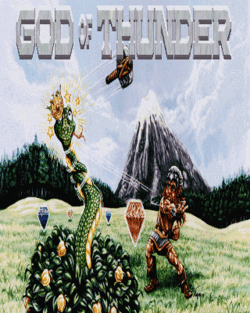God of Thunder (video game)
| God of Thunder | |
|---|---|
 | |
| Developer(s) | Adept Software |
| Publisher(s) | Software Creations |
| Designer(s) | Ron Davis |
| Platform(s) | DOS |
| Release date(s) | 1993 |
| Genre(s) | Puzzle, action |
| Mode(s) | Single player |
God of Thunder (abbreviated GoT) is a 2D platform/top-down freeware puzzle game created by Ron Davis and published by Software Creations in 1993. It was previously a shareware product but was released as freeware in 2002 or earlier. The game chronicles the quest of Thor, son of Odin and god of thunder as he tries to reclaim Midgard for his father. Midgard, the beloved land of Odin's, was stolen from the god during his "Odinsleep" by Loki, the god of mischief, with the help of Jormangund the serpent and Nognir, the Prince of the Underworld. To help in his quest, Thor is given the mythical hammer Mjolnir by Odin.

As Thor progresses, he must solve puzzles set before him by Jormangund, Nognir and finally Loki. He also has to fight his way through the countryside, past city guards, and into the lairs of the gods. Along with puzzles and action, role-playing elements are included. Thor slowly gains more powers as he progresses and his hammer and armor are upgraded when the player defeats one of the three bosses. Through the entire game, Odin watches over him and Thor will find himself admonished by the king of the gods if Mjolnir fells an innocent person.
The game features tongue-in-cheek humor, which becomes more apparent as the episodes are played. A bridge repairman parodies Star Trek when he responds to a request for a dental bridge with "Dammit, Thor! I'm a bridge and TV repairman, not a dentist!" Other examples of humor include countless references to sliding and non-stick surfaces in the second chapter, Non-Stick Nognir. The joke comes from Nognir's use of all of the male citizens in his area as slaves to mine Teflor, a parody of teflon. Stores also feature catchy or humorous slogans, such as "Andy's Armor Repair. You scuff 'em, We buff 'em." Probably the most blunt is a blatantly anachronistic use of a jig-saw in the 3rd episode.
The game also features several references to the Marvel Comics book character Thor. These include the idea of the Odinsleep, Loki's costume and a mention at the end that Thor should have his own comic book.
Gameplay
Thor's primary weapon is Mjolnir, a magical hammer which, when thrown, will return to Thor when it hits an object, an enemy, or the end of the screen. Upon its return, the hammer can pass through and damage multiple enemies. Mjolnir can also be used to flick switches, which control logs that come up from the ground and block passage. These logs are pointy, and kill Thor if he is standing over them while they come up. There are various other objects that block the path, each with different mechanics. For instance, barrels can be moved either horizontally or vertically depending on their orientation; some bushes can be destroyed to reveal secret entrances, and some rocks can be moved (these look very similar to the solid versions); round rocks will keep rolling once touched until it reaches an obstacle, which makes for extremely difficult puzzles.
In addition to his hammer, Thor acquires magical items which cost mana (the yellow bar at the bottom) and have various effects. The first, the magic apple, heals Thor; another item electrocutes any enemy nearby. Neither mana nor health regenerate, so they must be bought in villages or acquired from the random pickup provided by each slain enemy. These dead foes may also drop gems, the currency of the game. The colour of any item determines its value; a red items signifies 10 blue items.
Blocks with a key in them cost one key to remove; blocks with a dollar symbol in them cost 10 or 100 gems to remove. Plain grey blocks can be shoved aside and used to block enemy attacks. This is especially useful against the snake, which can kill the player instantly but may only attack horizontally or vertically.
Reception
Dragon's Sandy Petersen gave the game 3 out of 5 stars.[1]
External links
| Wikiquote has quotations related to: God of Thunder |
References
- ↑ Petersen, Sandy (August 1994). "Eye of the Monitor". Dragon (208): 61–66.